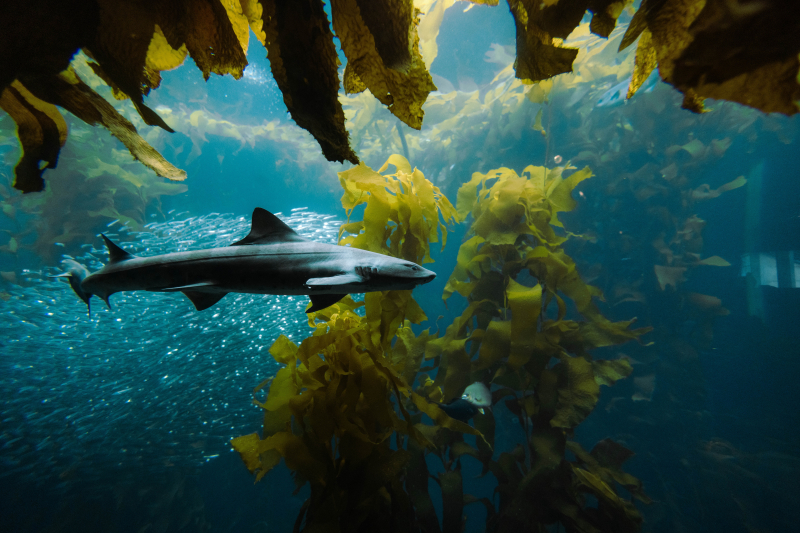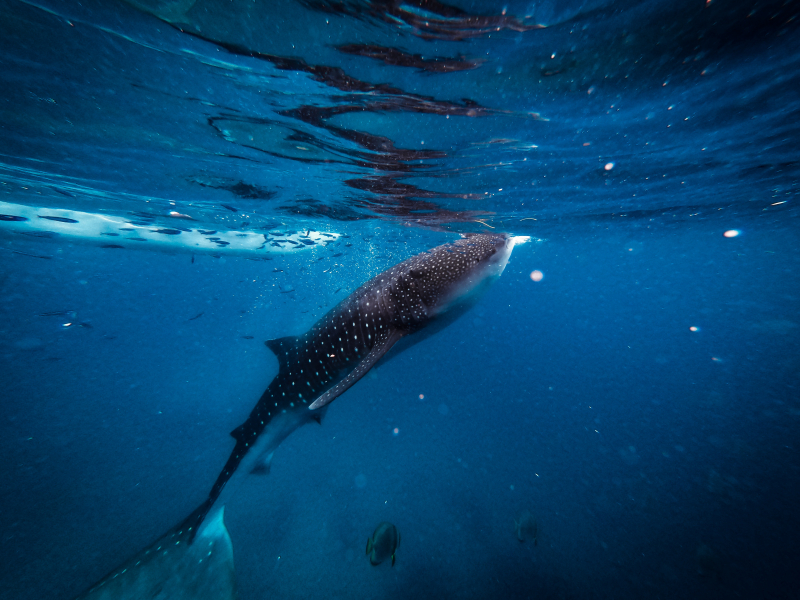Top 10 Facts About Sharks that Shark Week Hasn't Told You
The most hated animals on earth are sharks. Before swimming gained popularity, no one gave these animals any thought over the majority of human history. They ... read more...were noticed after a strange shark attack, and their demise was later assured by the release of Jaws. Following that, they were massacred in their numbers. Today, close to 100 million people every year are slaughtered. Sharks are incredible in ways that most people never realize, so it's a damn tragedy.
-
Sharks are renowned for being omnivorous eaters. A great white shark can survive on 66 pounds of food for around two weeks. Every day, a whale shark will eat 46 pounds of plankton. To put it simply, sharks can consume food. Additionally, not everything they eat is truly food. Some people have been discovered carrying unusual objects including wine bottles, drums, and even cannonballs.
It makes sense that there must be a mechanism for a shark to escape again given how much goes into it. Even though it's not in the way you'd anticipate, there is. Sharks can vomit in the most extravagant way imaginable by yanking their entire stomachs out of their mouths. The behavior is most frequently observed when sharks are under stress, such as when they are caught by fishermen or beached, for example.
It's thought that sharks use this action in addition to acting out of stress in order to essentially rinse their guts. They can dump it, wash it in seawater, and then suck it back in if they contain a lot of foreign objects or hazardous compounds. A shark may push its stomach out for a little period before swallowing it back in, and once this is done, they don't appear to be any worse off.
Image by GEORGE DESIPRIS via pexels.com 
Image by Vova Kras via pexels.com -
Great White sharks receive a lot of media attention due to films like Jaws and the fact that they are simply very large, however they are not thought to be the most deadly sharks in the ocean. Bull sharks deserve that distinction. Bull sharks are very combative and won't hesitate to defend their territory. Bear in mind that there aren't many shark attacks of any kind, but bull sharks are one of the more vicious marine animals. Additionally, the fact that they are not restricted to saltwater makes them seem a little more dangerous.
The majority of sharks must constantly live in saltwater in order to control the amounts of salt in their bodies. When a great white shark is submerged in freshwater, their body essentially becomes diluted with freshwater, which causes their cells to break down due to a lack of salt. However, a bull shark has evolved the capacity to recycle salt in its own body through its kidneys and some salt-retaining tail glands.
The fact that bull sharks often give birth in fresh or brackish water helps to safeguard the young from predators. Even though they eventually migrate to the sea, they may survive and thrive in freshwater.
Image by Daniel Torobekov via pexels.com 
Image by Taryn Elliott via pexels.com -
Numerous studies have shown that animals enjoy music. Cows produce more milk in response to classical music. It appears that elephants enjoy classical music as well. Sharks too? They do react to jazz.
Researchers found that sharks were more drawn to the sound of jazz music than something like classical music based on study that used food as an incentive. The sharks would move approach them when they played jazz music so they could obtain their food incentive. Sharks were bewildered when mixed with classical music, but be understanding because they are only fish.
The study is a nice addition to the theory that certain underwater noises, particularly boat motors, tend to attract sharks. Sharks can learn to approach specific sounds that might otherwise seem to provide nothing or even scare creatures away. People on boats often chum the seas, especially when they want to swim with sharks.

Image by Daniel Torobekov via pexels.com 
Image by adiprayogo liemena via pexels.com -
One of the world's most unbreakable organisms is the minuscule tardigrade. They can withstand extreme temperatures of -328 to 300 degrees Fahrenheit, mountaintops, the bottom of the ocean, and even outer space. No environment seemed to be too severe. And as it happens, some sharks have adopted some of the tardigrade's strategies.
Kavachi is the name of an underwater volcano that is close to the Solomon Islands. It is an active volcano that frequently erupts, spilling ash, lava, and toxic substances into the lake. While it was not erupting in 2015 when researchers went to examine, the water was still extremely hot and corrosive. Two species of sharks were spotted by a camera that was sent down and were present in the volcano's caldera.
The ocean surrounding the volcano is merely another extreme because sharks are known to be able to withstand deep water. It's thought that their capacity for electromagnetic signal detection may aid in their survival by alerting them before to the eruption of the volcano so they can flee the area.
Image by Mile Ribeiro via pexels.com 
Image by Lachlan Ross via pexels.com -
Although Jaws made us fear Great White sharks, cookiecutter sharks are the true terror of the deep. These small creatures have a true horror movie element to them, which is mainly their lips, despite only being 20 inches long. Their ability to almost perfectly bite circles out of their prey is how they got their name. and still more.
It appears that sharks enjoy biting practically anything, including nuclear submarines. When nuclear submarines first entered the ocean, their small size and distinctive mouths made any exposed non-metal parts the ideal prey for sharks. They bit cables, hoses, and everything else they could get their teeth on.
Subs were forced to return to the dock for repairs after being rendered blind by their attacks on rubber sonar domes. The little sharks' reign of terror was put an end, at least insofar as nuclear weapons were concerned, when the subs were later constructed with some stronger materials.

Image by Guryan via pexels.com 
Image by Adil Schindler via pexels.com -
There are many dangerous creatures in the world, and each one has a unique potential for danger. Hornets and bees, for example, attack in swarms. Cheetahs move quickly. Rattlesnakes are poisonous. Additionally, a shark swims quickly and possesses dangerous jaws. But that's all, at least. Except for a few shark species that are truly venomous as well.
It turns out that for a few species, including one that has been discovered in the Thames River in England, being a shark simply isn't terrifying enough. For many years, the Thames was virtually a trickle of death due to pollution, but recently, it has been steadily making a recovery, which has included sightings of spurdog sharks in the water. Spurdogs have envenomating spines in front of their dorsal fins and are slightly under two feet long.

Image by Ben Phillips via pexels.com 
Image by Mile Ribeiro via pexels.com -
You have probably heard that a shark hunts by detecting electrical signals in the water. And don't believe that will compensate for your bad vision. Sharks have ten times more vision than people have. And if that weren't enough, they also have a much more developed sense of smell than humans do.
Sharks can detect prey in stereo, not only through the water. One nostril will be affected before the other when a shark is swimming when there is injured prey in the water. You have probably heard that a shark hunts by detecting electrical signals in the water. And don't believe that will compensate for your bad vision. Sharks have ten times more vision than people have. And if that weren't enough, they also have a much more developed sense of smell than humans do.
Sharks can detect prey in stereo, not only through the water. One nostril will be affected before the other when a shark is swimming when there is injured prey in the water.
Image by isaac mijangos via pexels.com 
Image by Cam Green via pexels.com -
Whether or not sharks have a bad image, most people may find comfort in the fact that they would leave you alone if you did the same for them. We reside on land, whereas they are seafarers. If we don't want to, we never have to run into each other. Then you learn that some sharks can move about on land.
A few number of fish species that can truly walk on land have been discovered by science. Four new walking shark species were discovered in 2020. And if you read a tale about them, it describes how they can walk on the ocean floor and hunt for prey that hides under coral and rocks by using their pectoral fins. They're walking, but not "land" walking, so that's good, right?
Of fact, the epaulette shark can walk on land, which is a skill that probably developed to help it live if it becomes trapped in a pool or in the shallows when the tide recedes. They are capable of spending up to an hour dry land.
Image by Elgin Renz Rocili via pexels.com 
Image by Graham Henderson via pexels.com -
If you can see a shark coming, does it make it less or more frightening? Of course it's terrible when something appears out of nowhere and attacks you, but what if you can see it coming and are helpless to stop it? And in light of that, how frightened would you be of a shark that glows in the dark?
Because so few organisms in our environment are able to light, bioluminescence is still somewhat of a novelty to us. There are more than 1,500 different types of fish that can produce light in the ocean. These fish are typically found in deep waters, and they aren't usually sharks. Some of them, though, are. Three species in particular were found off the New Zealand coast. The kitefin shark is one of them and may reach lengths of almost six feet.

Image by Piya Nimityongskul via pexels.com 
Image by Piya Nimityongskul via pexels.com -
According to PETA, a shark is less likely to kill you than a champagne cork. Shark attacks are considerably more uncommon than most people realize, whether or not that is totally accurate. In 2020, unprovoked shark attacks claimed the lives of only 10 individuals. However, if you want to increase your chances of avoiding the net group of 10, pick your dive time properly.
It seems that sharks are the sea's equivalent of werewolves. When compared to other periods of the month, attacks typically occur more frequently during a full moon. More attacks occur when the moon is full. This gives the impression that shark attacks may increase because of the moonlight, despite the fact that most attacks actually take place during the day and coincide with these lunar phases.
Given how the tides affect the oceans, we are aware that the moon has a distinct impact there, but it is also plain that some sharks get upset by it.
Image by Leonardo Lamas via pexels.com 
Image by James Lee via pexels.com































